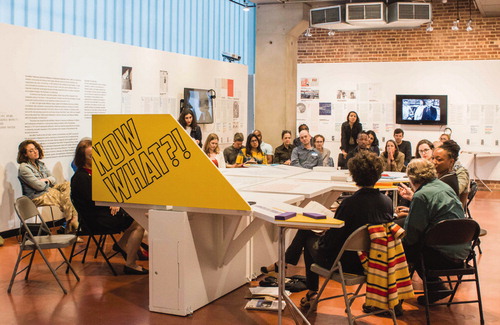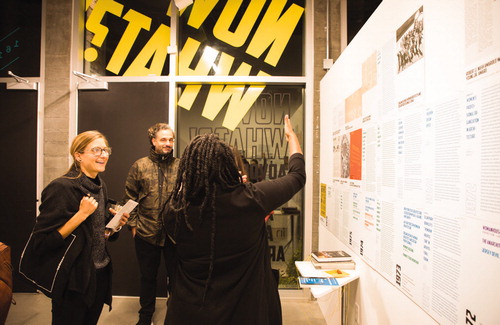New futures are being created right now, changing how we understand the discipline’s history. ArchiteXX is an organization committed to creating gender equity by bridging the academy and practice.1 We are using this essay to critically engage the powerful space of the Other while acknowledging that to be othered can mean to be disempowered, a pejorative act made to shut one down. Yet, as bell hooks wrote, “to be in the margin [or, as we argue, the space of the Other] is to be part of the whole but outside the main body.”2 Those at the margin are a “vital part of that whole.”3 It is this marginal condition that we proudly and unabashedly promote through our traveling exhibition, online catalog, and eventual publication, Now What?! Advocacy, Activism & Alliances in American Architecture Since 1968.
Now What?! contributes to and significantly expands upon what is deemed worthy of inclusion in architectural history and design discourse by connecting the discipline to America’s varied and complex social and political movements of the late twentieth and early twenty-first centuries—movements that have profoundly shaped this country. Foregrounding the long history of activism by minority groups in the profession, including intersections with the civil rights, feminist, LGBTQIA, and environmental movements of the last half century, Now What?! raises awareness of the myriad ways architects and designers contribute to creating more inclusive and reflective practices of engagement to build a more just world. One of our goals for the project is to inspire a more diverse student body to enter architecture to create a profession that better reflects the world architects serve. By equipping students with this history, we believe they will be emboldened to build on this important yet largely overlooked legacy, making inroads toward greater disciplinary change both in who becomes an architect and what sorts of projects architects engage in.
Figure 1. Now What?!, Pratt Institute School of Architecture, New York. (Photograph by Ben Erikson.)

We take up the challenge Paulo Freire wrote about in Pedagogy of the Oppressed, in which liberation education is a praxis: “the action and reflection of men and women upon their world in order to transform it.”4 This project aims to transform the discipline and the education of all future architects. As Now What?! travels to schools and communities around the world,5 our contributors and collaborators grow into an ever-expanding network of activists, scholars, archivists, professionals, and students. Now What?! writes a history that can only happen through engaging local, on-the-ground communities and their histories through an intersectional framework that brings multiple voices, genders, races, and socioeconomic levels into these conversations so they can lead them.
The four frames of the exhibition reflect the arenas of action for and by those who are sometimes on the margins of architecture. Who we see matters. The role of public programming, symposia, exhibitions, and publications are vitally important, contributing to a richer and more diverse dissemination of ideas and debate that impact practice. Through “Representation & Awards” (frame 1), the exhibition highlights the role of public programming in providing formats for critical thought and mobilization. We recognize that while the architecture awards system has historically promoted narrow definitions of practice, new award initiatives recognize and celebrate more diverse and engaged types of architectural practice.
Figure 2. Now What?!, Woodbury University School of Architecture, Los Angeles. (Photograph by Monica Nouwens.)

Figure 3. Now What?!, California College of the Arts, San Francisco. (Photograph by Mia Candelaria.)

Design is the architect’s most powerful tool for advocacy. “Advocacy by Design” (frame 2) provides examples of how architects merge their advocacy with their design work. Although buildings can reinforce and perpetuate unequal power relationships, designers also use their work to create change at various scales. This theme showcases examples of architects who use their design skills to create forms for advocacy and promote new alliances.
The way we teach significantly impacts the intellectual trajectories and experiences of students. “Academy & Pedagogy” (frame 3) includes efforts made by architectural educators and institutions to attract a greater range of students from diverse backgrounds. The theme also explores how the ongoing transformation of architectural research and teaching methodologies is profoundly influencing the discipline, whether by countering the architectural canon through inclusion of histories of marginalized communities or promoting broader definitions of architectural practice and spatial inquiry.
It is important to examine the cultures of design within the academy and the profession more broadly. These cultures become ingrained quite early in a student’s educational career. The expectations and practices taught in schools also have a profound impact on how students transition into the architectural workplace. “Design Culture & Workplace” (frame 4) provides examples of how organizations have fought against educational, employment, and workplace discrimination, and how they have expanded definitions of practice and advocated for a more equitable and sustainable workplace.
Now What?! celebrates and brings into view these vibrant, revolutionary Others, the hundreds of practitioners, educators, students, informal groups, organizations, and communities that have made and are making great strides in producing different futures for our discipline. Now What?! demonstrates how the space of the Other can become a powerful location to occupy, one that remains a space of radical potential. Now What?! continues to be exhibited in schools around the world, and we recognize, with hooks, that we are in fact occupying “the most radical space of possibility in the academy”—the classroom.6 Now What?! creates new possibilities, writes new histories, produces new and diverse bibliographies and case studies, and promotes activism and alliance building.
Websites and Associations
ArchiteXX: www.architexx.org
Association for Women in Architecture: www.awa-la.org
Beverly Willis Architecture Foundation: www.beverlywillisarchitecturefoundation.org
Black in Design: http://www.blackindesign.com/
Chicago Women in Architecture: http://www.cwarch.org/
Equity by Design, 2014 Equity in Architecture Survey Report and Key Outcomes: https://issuu.com/rsheng2/docs/equityinarch2014_finalreport
National Association of Minority Architects: http://www.noma.net/
Organization of Women Architects and Design Professionals: http://owa-usa.org/
Organization of Lesbian and Gay Architects and Designers (OLGAD), now Out Professionals: https://www.outprofessionals.org/
Design Industries Foundation Fighting AIDS (DIFFA): https://diffa.org/
Boston Gay and Lesbian Architects and Designers (BGLAD): https://network.aia.org/communities/community-home?CommunityKey= 6cb91d7c-05dc-4b48-97ea-b36b6034093e
Graduate School of Design African American Student Union (GDSAASU): https://harvardgsdaasu.wordpress.com/
FrameWorks Institute: http://www.frameworksinstitute.org/
The RL Mace Universal Design Institute: http://udinstitute.org/
Architects Designers Planners for Social Responsibility (ADPSR): http://www.adpsr.org/
The Architecture Lobby: http://architecture-lobby.org/
AIA Academy of Architecture for Justice
Notes
Additional information
Notes on contributors
Lori Brown
Lori Brown is a cofounder of ArchiteXX, a New York–based women and architecture organization. She is a professor and director of Diversity, Equity, and Inclusion at Syracuse University’s School of Architecture and has authored two books: Feminist Practices: Interdisciplinary Approaches to Women in Architecture and Contested Spaces: Abortion Clinics, Women’s Shelters, and Hospitals. She is coeditor with Dr. Karen Burns on the forthcoming Bloomsbury Global Encyclopedia of Women in Architecture 1960–2015 (2021). In 2016 she received a Beverly Willis Foundation Leadership Award for her work increasing recognition of gender inequities in the building industry.
Sarah Rafson
Sarah Rafson is an architectural writer, editor, curator, and researcher. She teaches at the Carnegie Mellon University School of Architecture, where she was the 2017–2018 Ann Kalla Professor. In 2016, after working on books and exhibitions with the Museum of Modern Art and Bernard Tschumi, she founded Point Line Projects, an editorial and curatorial agency for architecture and design.
Andrea J. Merrett
Andrea J. Merrett has recently completed a dissertation on the history of feminism in American architecture, “The Professional Is Political: The Women’s Movement in American Architecture, 1971–1985.” She received support for her work from the Buell Center, Schlesinger Library, and the International Archive of Women in Architecture. In addition to cocurating ArchiteXX’s exhibition Now What?!, currently touring North America, she is the area editor for the USA and Canada section of the Bloomsbury Global Encyclopedia of Women in Architecture 2015–2016 (2021).
Roberta Washington
Roberta Washington researches, writes, and lectures about early African American female architects and black architects in New York State, with biographies appearing in various books and online publications, including the Beverly Willis Architecture Foundation’s Pioneering Woman of Architecture. She is a fellow of the American Institute of Architects, a past president of the National Organization of Minority Architects, and past commissioner on New York City’s Landmarks Preservation Commission. Washington is principal of Roberta Washington Architects, PC.
Notes
1. See “Mission,” ArchiteXX, https://www.architexx.org/about.
2. bell hooks, preface to Feminist Theory: From Margin to Center (Boston: South End Press, 1984).
3. hooks, preface.
4. Paulo Freire, Pedagogy of the Oppressed, trans. Myra Bergman Ramos (New York: Continuum, 1993), 79.
5. As of spring 2020, the exhibition has been hosted by the following galleries and institutions: Pratt Institute School of Architecture (Brooklyn, NY), Woodbury University School of Architecture (Los Angeles, CA), California College of the Arts (San Francisco, CA), McGill University (Montreal, QC), Hobart & William Smith Colleges (Geneva, NY), University of Buffalo (Buffalo, NY), Co-Prosperity Sphere (Chicago, IL), Cornell University (Ithaca, NY), Kvinnors Byggforum (Stockholm, SE), and Kennesaw State University (Marietta, GA).
6. bell hooks, Teaching to Transgress: Education as the Practice of Freedom (New York: Routledge, 1994), 12.
More Information
- Anthony, Kathryn H. Designing for Diversity: Gender, Race, and Ethnicity in the Architectural Profession. Urbana, IL: University of Illinois Press, 2001.
- Bell, Carla Jackson, ed. Space Unveiled: Invisible Cultures in the Design. New York: Routledge, 2015.
- Cole, Doris. Candid Reflections: Letters from Women in Architecture 1972 and 2004. New York: Midmarch Arts Press, 2007.
- Design Legacies: A Tribute to Architects and Designers Who Have Died of AIDS. New York: Design Pride ‘94 International Lesbian & Gay Conference, 1994. Exhibition catalog.
- Eaklor, Vicki Lynn. Queer America: A GLBT History of the 20th Century. Westport, CT: Greenwood Press, 2008.
- Gooden, Mario. Dark Space: Architecture, Representation, Black Identity. New York: GSAPP Books on Architecture and the City, 2015.
- Hayden, Dolores. The Grand Domestic Revolution: A History of Feminist Designs for American Homes, Neighborhoods, and Cities. Cambridge, MA: MIT Press, 1981.
- Kaplan, Victoria. Structural Inequality: Black Architects in the United States. Lanham, MD: Rowman & Littlefield, 2006.
- Ostroff, Elaine, Mark Limont, and Daniel G. Hunter. Building a World Fit for People: Designers with Disabilities at Work. Boston: Adaptive Environments Center, 2002.
- Rendell, Jane, Barbara Penner, and Iain Borden, eds. Gender Space Architecture: An Interdisciplinary Introduction. London: Routledge, 2000.
- Retter, Yolanda, Anne-Marie Bouthillette, and Gordon Brent Ingram, eds. Queers in Space: Communities, Public Places, Sites of Resistance. Winnipeg: Bay Press, 1997.
- Spain, Daphne. Constructive Feminism: Women’s Spaces and Women’s Rights in the American City. Ithaca, NY: Cornell University Press, 2016.
- Stimpson, Catharine R., Elsa Dixler, Martha J. Nelson, and Kathryn B. Yatrakis, eds. Women and the American City. Chicago: University of Chicago Press, 1981.
- Stratigakos, Despina. Where Are the Women Architects? Princeton, NJ: Princeton University Press, 2016.
- Torre, Susana, ed. Women in American Architecture: A Historic and Contemporary Perspective. New York: Whitney, 1977.
- Travis, Jack, ed. African-American Architects in Current Practice. New York: Princeton Architectural Press, 1991.
- Valk, Anne. Radical Sisters: Second Wave Feminism and Black Liberation in Washington, D.C. Champaign, IL: University of Illinois Press, 2007.
- Weisman, Leslie Kanes. Discrimination by Design: A Feminist Critique of the Man-Made Environment. Urbana, IL: University of Illinois Press, 1992.
- Wilson, Dreck Spurlock, ed. African American Architects: A Biographical Dictionary 1865–1945. New York: Routledge, 2004.
- Wiese, Andrew. Places of Their Own: African American Suburbanization in the Twentieth Century. Chicago: University of Chicago Press, 2005.
